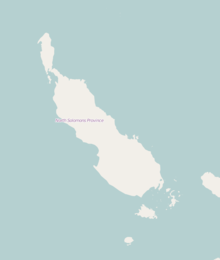Panguna mine
 Copper ore concentrator undergoing construction, c. 1971 | |
| Location | |
|---|---|
| Autonomous Region of Bougainville | |
| Country | Papua New Guinea |
| Coordinates | 6°18′54″S 155°29′42″E / 6.315°S 155.495°E |
| Production | |
| Products | |
| Type | Open pit |
| History | |
| Opened | 1972 |
| Closed | 1989 |
| Owner | |
| Company | Bougainville Copper |
The Panguna mine is a large
The mine has been closed since 1989 and has ceased all production.History
The discovery of vast copper ore deposits in
Profits derived from the mine helped fund Papua New Guinea's independence from Australia, in 1975.[5]
Mining at Panguna included the direct discharge of
In June 2016, Rio Tinto relinquished its role by divesting its interests in the mine to national and local governments.[8] In 2020, the Human Rights Law Centre lodged a complaint with the Australian government regarding adverse environmental and human rights impacts of the mine.[9]
Environmental impacts
The environmental impacts of the mine continue to this day. Many people have had to relocate to higher ground to avoid contaminated drinking water.[9] Heavy metals such as copper, zinc, and mercury are found in the surrounding rivers.[10] Rio Tinto has refused to fund remediation works, stating that it fully complied with the relevant laws during mining operations.[8]
Reopening
The autonomous government of Bougainville wants to reopen the mine for the purposes of seeking an independent funding source.[10] Estimates place the cost of reopening the mine at $5 to $6 billion.[10]
Gallery
-
Ore mill at Panguna, Boungainville mine under construction, c. 1971
-
Shovel at Panguna mine undergoing maintenance, engaged in overburden removal, c. 1971.
See also
References
- ^ "Panguna Copper Project". portergeo.com. 2012. Retrieved 26 July 2013.
- ISSN 0261-3077. Retrieved 18 June 2020.
- ^ Mcdonald, Joshua. "Will Bougainville Reopen the Panguna Mine?". thediplomat.com. The Diplomat.
- ^ "Panguna | Papua New Guinea". Encyclopedia Britannica. Retrieved 10 August 2020.
- SBS. 22 November 2019. Retrieved 7 June 2023.
- . Retrieved 6 June 2023.
- ^ "History of Panguna mine". Retrieved 15 January 2020.
- ^ a b Skidmore, Zachary (6 September 2021). "Rio Tinto and the legacy of the Panguna mine". Mining Technology. Verdict Media. Retrieved 7 June 2023.
- ^ a b Swanston, Tim; Gunga, Theckla (6 June 2023). "Bougainville's destructive goldmine could also be its $90 billion key to independence". ABC News. Australian Broadcasting Corporation. Retrieved 7 June 2023.
- ^ a b c Wilson, Catherine (6 May 2022). "Bougainville starts process to reopen controversial Panguna mine". Al Jazeera. Retrieved 7 June 2023.
External links
![]() Media related to Panguna mine at Wikimedia Commons
Media related to Panguna mine at Wikimedia Commons



